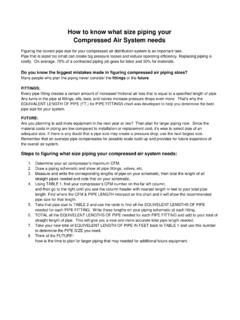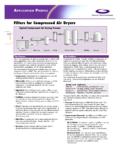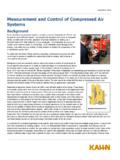Transcription of Top 12 Compressed Air Safety Guidelines
1 Top 12 Compressed Air Safety Guidelines1. Never apply Compressed air to the skin or direct it at a person. Even air at a pressure of 15 psig can cause serious injury. Never use a Compressed air hose to clean dirt or dust from your clothing or When using Compressed air for cleaning purposes, ensure pressure does not exceed 30 psig (per OSHA regulations). Always use goggles or a face shield over approved Safety glasses for this application. 3. Wear ear protection. Exposure to excessive noise can damage hearing. Noise reducing mufflers can be fitted to machines to lessen the noise health Never crimp, couple, or uncouple pressurized hose. Shut off valves and bleed down pressure before making any hose Use heavy duty clamps and fittings made especially for Compressed air only the correct type and size of hose end fittings and connectors. 6. Never use frayed, damaged or deteriorated hoses.
2 Always store hoses properly and away from heat sources or direct sunlight. A hose failure can cause serious injury. Hose Reels can decrease your chances of injury, as well as help hoses last longer. 7. When blowing Compressed air through a hose or air line, ensure that the open end is held securely. A free end can whip and can cause injury. Open the supply air valve carefully and ensure that any ejected particles will be restrained. A blocked hose can become a dangerous Compressed air gun. 8. Make sure all hoses exceeding 1/2 inch ID have a Safety device at the source of supply or branch line to reduce the pressure in case of hose failure (per OSHA regulations).9. Do not use air directly from a compressor for breathing purposes unless the system has been specifically designed for such purpose and suitable breathing air filters and regulators are in Isolating valves should be of the self venting type and designed to be locking in the "off" position so that air pressure cannot be applied accidentally while the machine is being worked Never alter or install an Safety relief valve that has a higher PSIG rating than the pressure vessel rating to which it is Only pressure vessels built to a national or international standard should be used for air for your Safety byMcGuire Air Compressors, Inc.
3 1-888-229-9999













